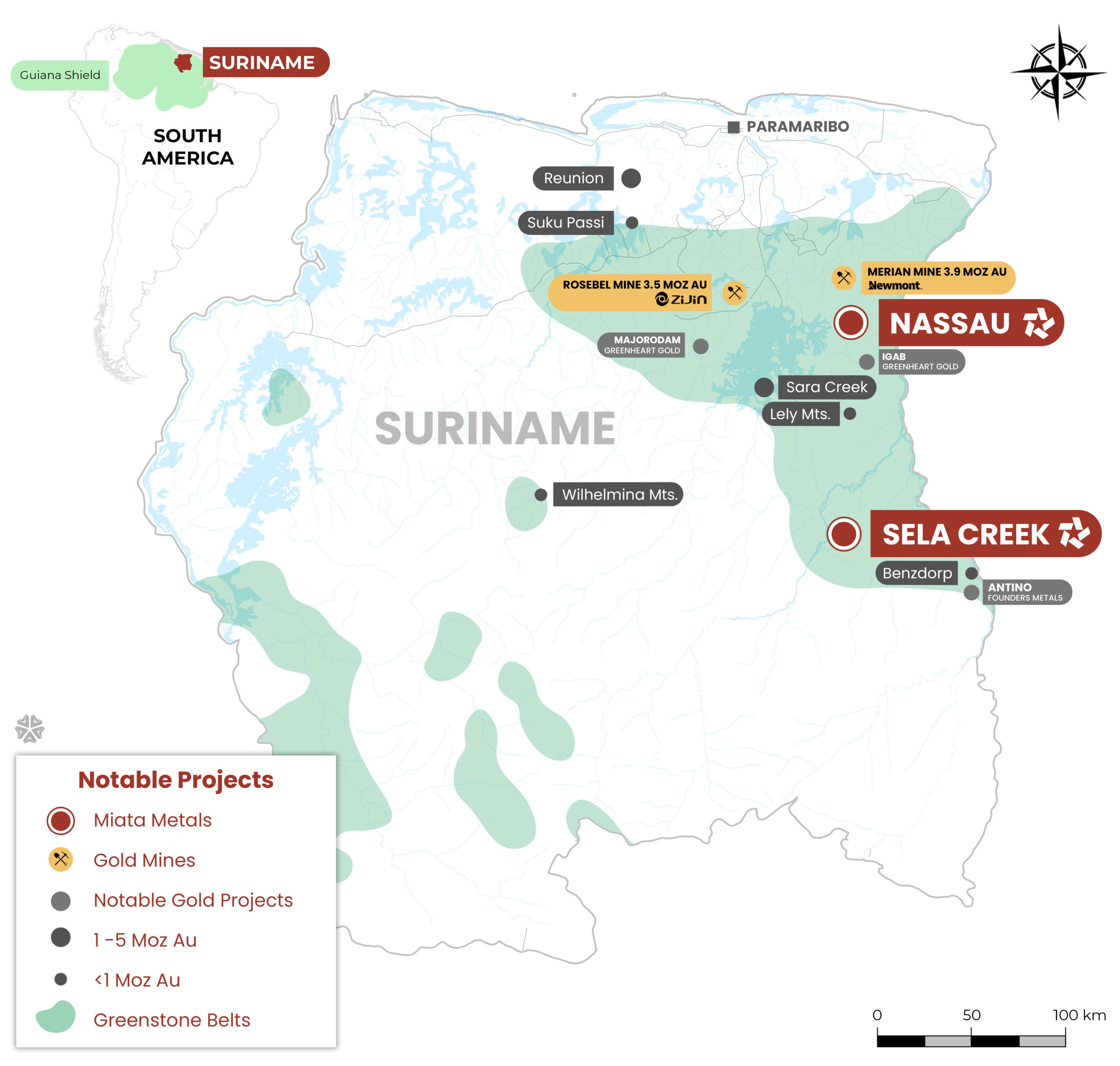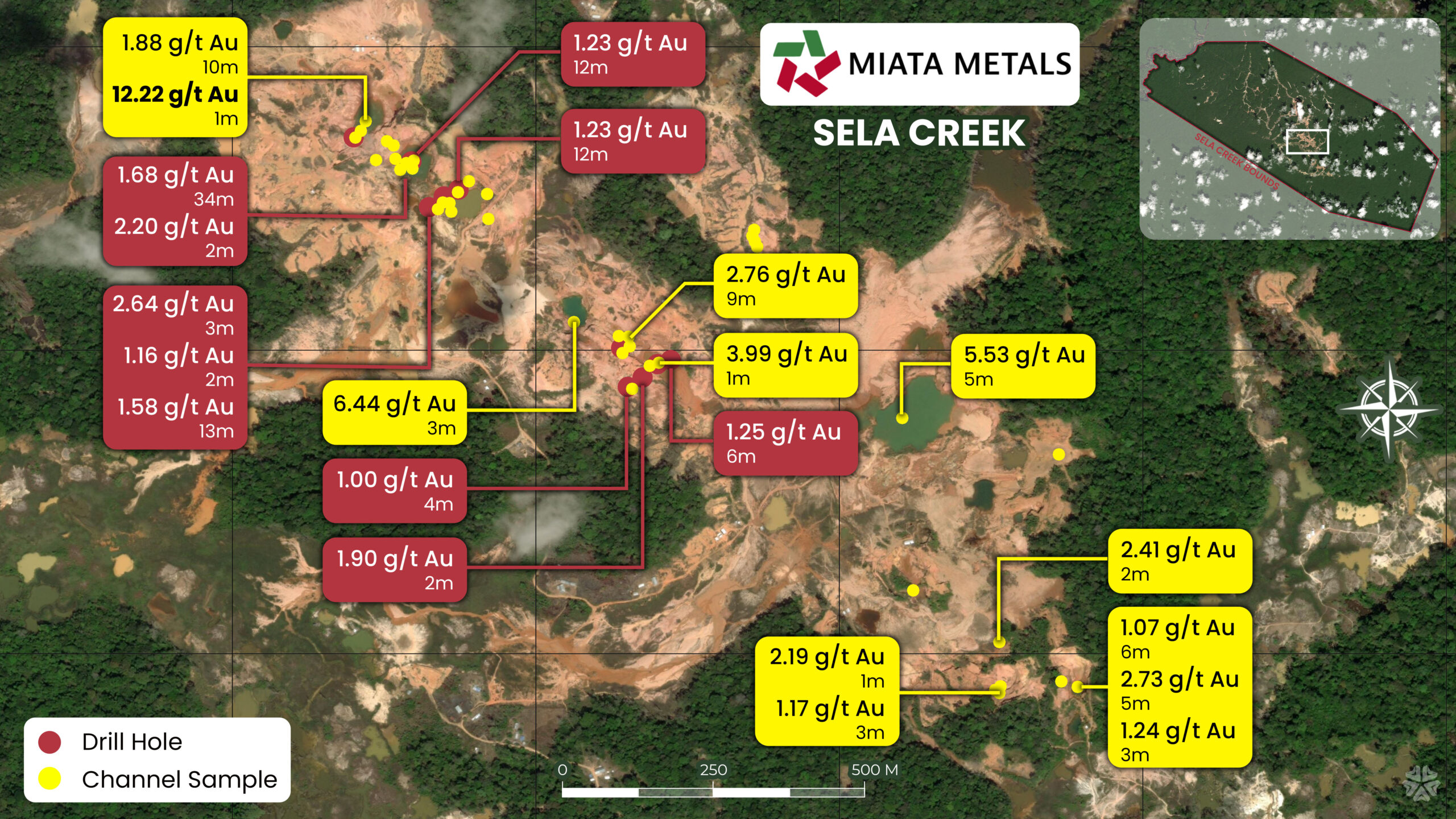
Sela Creek gold project
Sela Creek Gold
Miata Metals has a 70% earned interest in the Sela Creek Project, with an option to earn up to 100%. The Sela Creek Project covers >200km² of the Guiana Greenstone belt, with a 30km² area that has been mined for decades artisanally. The project contains seven main pits/targets that are encompassed by two large shear zones.
Alluvial gold mining all around a central plateau.
Alluvial gold miners gradually moving up slope and into bedrock.
Ample vein sets exposed, with excellent grades.
Only a few hours by truck from Paramaribo, the capital of Suriname.
10 km Southwest of Newmont’s Merian Mine.
The Company has a 70% earned interest in the Nassau Project
Sela Creek Gold
The Sela Creek gold project in Suriname has been mined for alluvial gold and is currently mined for gold in weathered bedrock, called saprolite. Local miners started small-scale mining at Sela Creek in the period from 1920-1930, one of the earliest gold occurrences found in the Tapanahony river area. Past and current mining and production span an area of 30 km2. Despite this extensive production1, only limited exploration for gold in bedrock has taken place. The first drilling was done by Hunter Bay in 2012 with positive results. 79North acquired Hunter Bay in 2017 but conducted minimal exploration. Miata Metals has an option to earn-in to 100% of the Sela Creek Project, with a 70% interest already earned through its acquisition of 79North.
- Scheduled flights from the Zorg en Hoop airstrip in Paramaribo to Drietabikki, and from Drietabikki a motorized canoe to travel 40 km upstream on the Tapanahony River to the small village of Paaston at the northwestern edge of the Sela Creek concession.
- Fuel and heavy equipment can be brought in by motorized canoe from Albina.
- A helicopter from Paramaribo can reach the field area in about 1 hour.
- From the village of Paaston the majority of the concession is accessed by four-wheel drive all-terrain vehicles (ATV) along dirt tracks created by small-scale miners.
Suriname is set in the Guiana shield, a massif of rocks of Paleoproterozoic age in the northwest corner of South America between the Orinoco and Amazon River basins, to the north and south respectively (Gibbs and Barron, 1993). Granite-greenstone-belts occur predominantly in the northern part of the shield between Venezuela and French Guiana, trend roughly NE-SW, and span a geographic distance of about 200 km.
Gold Mineralization
Gold mineralization at Sela Creek is observed within a northwest trending corridor that has a strike length of over 7 km and extends through the central part of the concession. In 2013, there were five main prospects within the central mineralised corridor: Central Ridge, Cambior, Stranger, Jons Pit and Puma. Continued small scale mining opens new pits and the older pits are flooded or filled with tailings. Past operators recognized that the Paaston and Panther prospects may represent separate mineralized trends. Mineralization is spatially associated with the faulted contact of a moderate intensity magnetic unit of likely felsic intrusive affinity, and a more widespread schist with slightly lower magnetic signature. This interpretation is supported by localisation of alluvial pits along the faulted contacts between the two magnetically distinct units, and the fact that almost all of the drainages that have sources at these contacts have been mined for placer gold.
Geological Context
Rocks of the Guiana Shield correlate to other rocks in various terranes in the circum-south-Atlantic continents that were involved in the Transamazonian – Eburnean (name used in Africa) orogeny. This age of rocks is a major source of gold production and resources both in eastern South America and west Africa, which were linked together prior to the opening of the Atlantic Ocean. The Guiana shield and most notably its counterpart in West Africa host many gold mines which typically consist of multiple shear- and fold-hosted orogenic deposits of which single deposits can exceed a million ounces of gold.
The entire Guiana Shield has undergone prolonged chemical weathering under a humid, tropical paleoclimate that may have started as far back as the Cretaceous period. Weathering has produced laterite and saprolite profiles up to 100 meters in depth. The soft rock allows for low-cost mining due to reduced milling cost.
Historical data showing drill hole intersects (verified by the company) and channel samples (unverified) collected by past operators. More detailed drill hole data can be found by following the link on this page to the NI43-101 report on Sela Creek.
Sela Creek Gold
From January 2011 through 2013, Sela Creek was explored using high-resolution satellite imagery, airborne geophysics, soil, channel and rock-chip geochemical sampling programs, reconnaissance and prospect scale mapping and diamond core drilling. Nine (9) diamond core holes totaling 1693.5 m were drilled in five fences at Jons Pit. The drilling encountered rock types typical of greenstone belts, all of which are locally mineralized. Drilling intercepts include:
SKD001
42.0 m @ 1.22 g/t Au (SKD001)
including 15.0 m @ 2.42 g/t Au
SKD002
28 m @ 1.12 g/t Au (SKD002)
including 2 m @ 5.89 g/t Au and 3 m @ 2.45 g/t Au
SKD008
8.0 m @ 2.70 g/t Au (SKD008)
including 4.0 m @ 4.57 g/t Au
The Central Guiana Shield Shear Zone (CGSZ) is a major structure that runs along the southwestern boundary of the concession, and a semi parallel splay of the CGSZ represents the northeastern boundary of the concession. The interaction of these two structures has created an area of extension for gold-rich fluids and intrusive rocks to access the highly deformed sedimentary and volcanic sequence of the greenstone belt.
Sampling completed on the Sela Creek Gold project in July 2024 yielded several high-grade occurrences of gold. Most notably the newly exposed Stranger Pit yielded high gold grades over a significant area.
The primary gold trend has an apparent north-north-east trend but may represent a sequence of mega-scale extensional structures and the Jons trend occurs along one such extensional structure. These structural and intrusive features indicate an excellent region for gold exploration where a new major gold deposit may be established should continued exploration be successful.
All mining on the claim is currently done by artisanal miners and not by Miata. Miata does not generate revenue from mining activities or royalties.
Referenced nearby projects, deposits and mines are not necessarily indicative that they hosts similar potential, size or grades of mineralization as the Nassau and Sela Creek Projects. 1 Dec 2023 – Merian Mine had reserves of 3.9Moz at 1.16 g/t gold (Proven and Probable) – ‘Newmont Resources and Reserves 2023’ 2. Dec 2022 Rosebell had reverves of 3.5 million ounces of gold at 1.1 g/t (Proven and Probable) – IAMGOLD Attributable Reserves, Feb 2023.
Drilling results were verified by the Company through re-assaying select intervals. Grab and channel samples are historical information.
Grab samples are by definition selective. Grab samples are solely designed to show the presence or absence of mineralization, and are not intended to provide nor should be construed as a representative indication of grade or mineralization at the Project.


